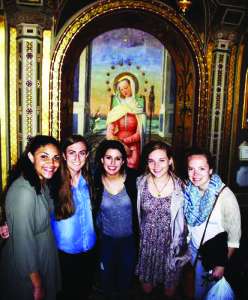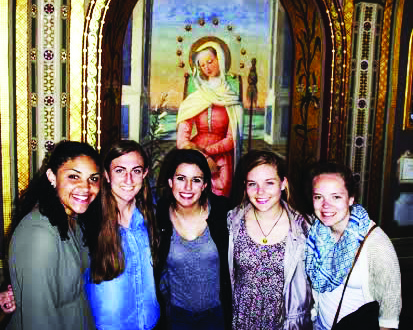Students were invited this spring break to climb Machu Picchu, saunter along Parisian promenades, visit Italian ruins in the small town of Ostia, or explore Spain’s capital like a true madrileña. The language department at Stone Ridge hosted four trips, impeccably well-planned and unbelievably rewarding–not only because students were engrossed in the language they are studying all year, but because of unparalleled cultural experiences in the countries where the languages originated.
Exploring the ruins of the ancient Roman Forum, Suzanne Antoniou, ‘16, linked together her location and her subject material. Suzanne’s Latin class makes a lot of references to the Forum, so she enjoyed physically being in and seeing firsthand a place that her class discusses so frequently. They discuss the Roman Triumph, the procession of successful warriors back into Rome, and were then able to walk through where it took place.
Peruvian cultural experiences followed Camilla Duke, ‘16, from online textbook to Peru. She read a passage for her AP Spanish Language class about how vital quinoa’s nutrients and cultivation are in Peru. Then, she was able to travel to Peru with her peers and actually taste and come to enjoy Peruvian quinoa soup. It consisted of broth similar to soup broth you would find here, along with quinoa and potatoes. According to Camilla, quinoa, a grain indigenous to the region, was everywhere.
Anneliese Goetz, ‘16, also names the food as one of her major highlights in Rome. She especially enjoyed the gelato, Italian ice cream, which was easily accessible at all times of day, since “there was a gelato shop on almost every corner.” Pastas, especially gnocchi, small Italian potato dumplings, were also exception in their place of origin.
Spain’s national dish, paella, al dente rice flavored with saffron, was mouthwateringly perfect. In Segovia, the town that the Stone Ridge Spain trip visited during the day, former Roman control influenced not only the architecture of the enormous aqueduct, but the cuisine as well. Many girls ate Italian food that day, as many restaurants in Segovia melded Spanish and Italian cooking.
Explorica, the travel tour company Stone Ridge used for the four trips, preorders dinners. If you have critical dietary restrictions, perhaps you may want to take that into consideration when deciding if you should sign up for a trip. You can list your dietary restrictions in advance; however, restaurants are not extremely receptive to them. If you have any dietary restriction, regardless of what it is, many restaurants will likely give you grilled vegetables, since everyone can eat that.
The trips were blessed with incredible local tour guides via Explorica. Even girls in the junior cloak room were discussing after they returned from the trip their wish for their tour guide to visit them here in Washington, D.C. The tour guides made witty jokes and truly brought plucky spunk to the groups. In Madrid, Adriana started to cry when the girls were about to leave her and return home.

Students also engaged and conversed not only with other members of the school, but with the locals. In Rome, a few girls joined some Italian kids playing soccer on the street. In Madrid, students talked with other Spanish teenagers while waiting outside of El Prado. Each time a waiter approached or a cash register was about to speak, students would take the initiative to begin speaking in a non-native tongue. They took advantage of every opportunity to mesh with the locals.
Students also ventured out of capital cities. In France, they discovered the true heart of France by visiting horse stables, châteaus, castles, and cathedrals. They visited cities including Nantes, Chinon, and Oranje. Those on the trip to Spain ventured away from centrally located Madrid in all directions, visiting Toledo, Segovia, and Salamanca during the days and returning to Madrid at night. Those in Rome ventured to Ostia and Pompeii. They truly got a feel for the entire country by advancing past major cities and discovering smaller towns.
Perhaps what made the Rome and France trips the most magical were their connections to the Sacred Heart. In France, Stone Ridge girls shared a lovely dinner with other Sacred Heart students from New Zealand and Nantes, France. “The dinner was a good way to share conversation with other children of the Sacred Heart and bond over what we had in common,” according to Lacey Foster, ‘16. Students on the Rome trip experienced an exclusive Sacred Heart tradition at the top of the Spanish Steps.
Anneliese Goetz was dumbfounded upon finally viewing Mater Admirabilis. She was able to witness firsthand, before her own two eyes, the miracle of Mater that had been related to her for years by Ms. Fazio and Sister Jenkins. She notes that after attending Stone Ridge for twelve years, she formerly saw “Mater as more of an icon.” Anneliese had colored pictures of Mater as a kindergartner. She had dressed up in pink, emulating Mater’s pink dress, throughout lower and middle school on her feast day. She has walked past her image on her way to assembly and lunch every day of high school. Christina Hsu, ‘16, deems her visit to Mater as the highlight of her trip. Christina says that in order to see the painting, “you must show them your school ID or class ring, as a symbol that you truly belong to the Sacred Heart.” Even if you are not on a school trip but are passing through Rome, be sure to walk to the top of the Spanish Steps, show your class ring, and ask to be shown the picture of Mater Admirabilis; according to its recent viewers, you can instantly witness and finally comprehend the extraordinary miracle that took place there.


Leave a Reply